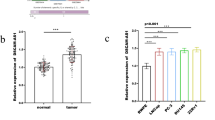Summary
MicroRNAs (miRNAs) modulate the expression of tumorigenesis-related genes and play important roles in the development of various types of cancers. It has been reported that miR-144 is dysregulated and involved in multiple malignant tumors, but its role in renal cell carcinoma (RCC) remains elusive. In this study, we demonstrated miR-144 was significantly downregulated in human RCC. The decreased miR-144 correlated with tumor size and TNM stage. Moreover, overexpression of miR-144 in vitro suppressed RCC cell proliferation and G2 transition, which were reversed by inhibition of miR-144. Bioinformatic analysis predicted that mTOR was a potential target of miR-144, which was further confirmed by dual luciferase reporter assay. Additionally, the examination of clinical RCC specimens revealed that miR-144 was inversely related to mTOR. Furthermore, knocking down mTOR with siRNA had the same biological effects as those of miR-144 overexpression in RCC cells, including cell proliferation inhibition and S/G2 cell cycle arrest. In conclusion, our results indicate that miR-144 affects RCC progression by inhibiting mTOR expression, and targeting miR-144 may act as a novel strategy for RCC treatment.
Similar content being viewed by others
References
Siegel R, Ma J, Zou Z, et al. Cancer statistics, 2014. CA Cancer J Clin, 2014,64(1):9–29
Motzer RJ, Molina AM. Targeting renal cell carcinoma. J Clin Oncol, 2009,27(20):3274–3276
Russo P. Renal cell carcinoma: presentation, staging, and surgical treatment. Semin Oncol, 2000,27(2):160–176
Bartel DP. MicroRNAs: genomics, biogenesis, mechanism, and function. Cell, 2004,116(2):281–297
Winter J, Jung S, Keller S, et al. Many roads to maturity: microRNA biogenesis pathways and their regulation. Nat Cell Biol, 2009,11(3):228–234
Fu YF, Du TT, Dong M, et al. Mir-144 selectively regulates embryonic alpha-hemoglobin synthesis during primitive erythropoiesis. Blood, 2009,113(6):1340–1349
Rasmussen KD, Simmini S, Abreu-Goodger C, et al. The miR-144/451 locus is required for erythroid homeostasis. J Exp Med, 2010,207(7):1351–1358
Fu X, Huang X, Li P, et al. 7-Ketocholesterol inhibits isocitrate dehydrogenase 2 expression and impairs endothelial function via microRNA-144. Free Radic Biol Med, 2014,71(6):1–15
Fan JY, Yang Y, Xie JY, et al. MicroRNA-144 mediates metabolic shift in ovarian cancer cells by directly targeting Glut1. Tumour Biol, 2015, [PMID: 26662316]
Liu J, Xue H, Zhang J, et al. MicroRNA-144 inhibits the metastasis of gastric cancer by targeting MET expression. J Exp Clin Cancer Res, 2015,34(1):35
Matsushita R, Seki N, Chiyomaru T, et al. Tumour-suppressive microRNA-144-5p directly targets CCNE1/2 as potential prognostic markers in bladder cancer. Br J Cancer, 2015,113(2):282–289
Lovat F, Valeri N, Croce CM. MicroRNAs in the pathogenesis of cancer. Semin Oncol, 2011,38(6):724–733
Poudel S, Song J, Jin EJ, et al. Sulfuretin-induced miR-30C selectively downregulates cyclin D1 and D2 and triggers cell death in human cancer cell lines. Biochem Biophys Res Commun, 2013,431(3):572–578
Budhu A, Jia HL, Forgues M, et al. Identification of metastasis-related microRNAs in hepatocellular carcinoma. Hepatology, 2008,47(3):897–907
Zhao LY, Yao Y, Han J, et al. miR-638 suppresses cell proliferation in gastric cancer by targeting Sp2. Dig Dis Sci, 2014,59(8):1743–1753
Aravalli RN, Steer CJ, Cressman EN. Molecular mechanisms of hepatocellular carcinoma. Hepatology, 2008, 48(6):2047–2063
Zhai J, Qu S, Li X, et al. miR-129 suppresses tumor cell growth and invasion by targeting PAK5 in hepatocellular carcinoma. Biochem Biophys Res Commun, 2015,464(1): 161–167
Kasinski AL, Kelnar K, Stahlhut C, et al. A combinatorial microRNA therapeutics approach to suppressing non-small cell lung cancer. Oncogene, 2015,34(27): 3547–3555
Kelnar K, Peltier HJ, Leatherbury N, et al. Quantification of therapeutic miRNA mimics in whole blood from nonhuman primates. Anal Chem, 2014,86(3):1534–1542
Si ML, Zhu S, Wu H, et al. miR-21-mediated tumor growth. Oncogene, 2007,26(19):2799–2803
Chen S, Li P, Li J, et al. MiR-144 inhibits proliferation and induces apoptosis and autophagy in lung cancer cells by targeting TIGAR. Cell Physiol Biochem, 2015,35(3): 997–1007
Yu H, Sun H, Bai Y, et al. MEF2D overexpression contributes to the progression of osteosarcoma. Gene, 2015,563(2):130–135
Cao T, Li H, Hu Y, et al. miR-144 suppresses the proliferation and metastasis of hepatocellular carcinoma by targeting E2F3. Tumour Biol, 2014,35(11):10759–10764
Guan H, Liang W, Xie Z, et al. Down-regulation of miR-144 promotes thyroid cancer cell invasion by targeting ZEB1 and ZEB2. Endocrine, 2015,48(2):566–574
Guertin DA, Sabatini DM. Defining the role of mTOR in cancer. Cancer Cell, 2007,12(1):9–22
Xiong Y, Yepuri G, Forbiteh M, et al. ARG2 impairs endothelial autophagy through regulation of MTOR and PRKAA/AMPK signaling in advanced atherosclerosis. Autophagy, 2014,10(12):2223–2238
Ribback S, Cigliano A, Kroeger N, et al. PI3K/AKT/ mTOR pathway plays a major pathogenetic role in glycogen accumulation and tumor development in renal distal tubules of rats and men. Oncotarget, 2015,6(15): 13036–13048
Bailey ST, Zhou B, Damrauer JS, et al. mTOR inhibition induces compensatory, therapeutically targetable MEK activation in renal cell carcinoma. PLoS One, 2014,9(9): e104413
Author information
Authors and Affiliations
Corresponding author
Rights and permissions
About this article
Cite this article
Xiang, C., Cui, Sp. & Ke, Y. MiR-144 inhibits cell proliferation of renal cell carcinoma by targeting MTOR. J. Huazhong Univ. Sci. Technol. [Med. Sci.] 36, 186–192 (2016). https://doi.org/10.1007/s11596-016-1564-0
Received:
Revised:
Published:
Issue Date:
DOI: https://doi.org/10.1007/s11596-016-1564-0




